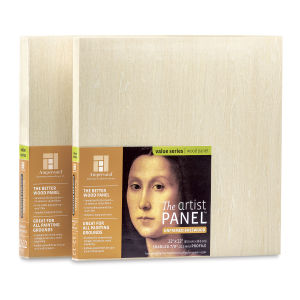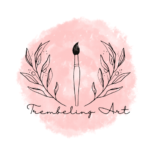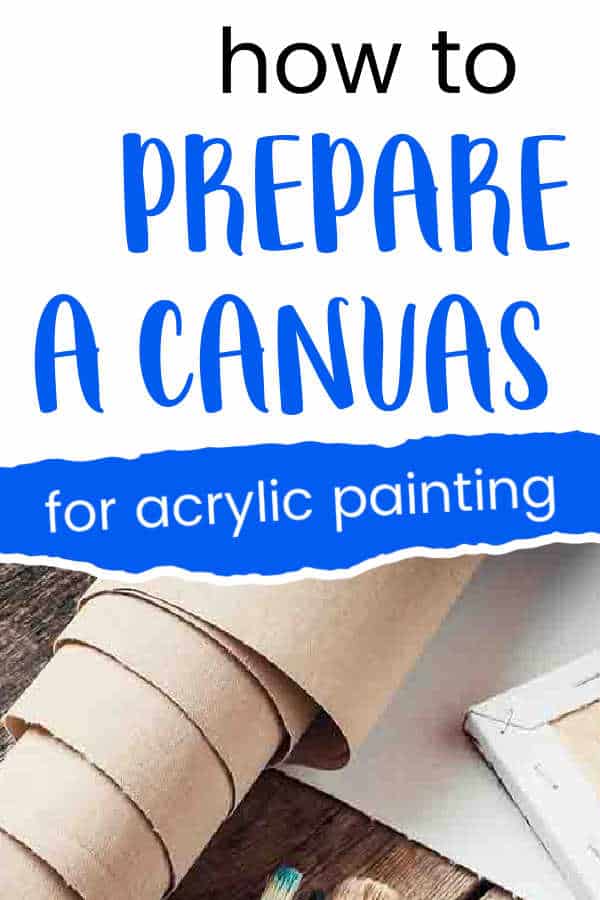How to prepare a canvas for acrylic painting is one of the first things you should learn as a beginning artist.
Gessoing is a process of applying layers of gesso to the canvas or other substrate to prepare the surface for painting.
A correctly prepared canvas will give you a much more satisfactory result and prevent the frustration of the paint not sticking. Preparing your surface properly can give you a smooth surface or a more textured surface if that is what you are going for.
An unprimed canvas needs a few coats of gesso to give the paint some “tooth” to stick to. Primed canvases can also benefit from a coat or two of gesso, as I will explain below.

Gesso can also be used to cover mistakes or start over when you don’t like the way your painting has turned out.
Read my post on practice canvases to see how you can use gesso to cover up a failed painting.
This post may contain affiliate links. If you click a link and buy, I may receive a small commission. Please see my full privacy policy for details.
What Is Gesso?
The word gesso is an Italian word taken from the Latin word “gypsum.” Traditional gesso was made with rabbit skin glue, chalk, and white pigment to give it an opaque white color.
Today’s gesso is a combination of acrylic polymer medium (binder), chalk, and paint pigment, as well as other chemicals. It dries hard but is somewhat flexible and prevents the paint from soaking into the weave of the canvas.
Acrylic gesso is used to prepare or prime a canvas, board, paper, or just about any surface for painting.
Traditionally, gesso was only white, but now it is available in black and various colors. You can also purchase a clear gesso if you do not want any color. A small amount of acrylic paint can be added to the gesso to give your project a custom-colored base.
You can buy gesso in various sizes, from 2-ounce bottles to large tubs. If you gesso a lot of canvases or a very large canvas, the large tub is more economical.
You can purchase gesso in various thicknesses, from very thin to super thick, which is great for getting extra texture. I like this Liquitex Gesso because it is economical and covers well.
Use professional artist-grade gesso if you can afford it. Avoid dollar store gesso as it doesn’t have enough of the necessary binders to stick well to the canvas and is not usually archival.
Why Prime a Canvas with Gesso?

Most pre-made stretched canvases and canvas boards come already primed. You don’t necessarily have to prime these canvases. However, some manufacturers coat the canvases with a type of silicone to prevent them from sticking together when shipping.
Silicone and acrylic paint don’t play well together, so you will likely have trouble getting your paint to behave the way you want.
Some artists wash the surface of the canvas with a damp cloth. Others give the canvas a few coats of gesso to cover any silicone or other residue and ensure good paint adhesion.
A good quality, professional-grade pre-primed canvas should have no issue with the paint sticking, but the texture of the canvas might not be what you want for your particular painting.
If your canvas is a little too rough for your type of painting, a few coats of gesso, with sanding in between, can give you a smoother surface to work with.
Similarly, if the canvas is not rough enough, gesso can give it that extra bit of texture you need, just skip the sanding. How to prep the canvas depends somewhat on personal preference and the type of painting you are doing.
Note: If you paint with acrylics, you need an acrylic-primed canvas, not an oil-primed one. The canvas should be marked for acrylics, oils, or both.
Of course, a raw cotton canvas or a raw linen canvas requires a few coats of gesso to prevent the paint from sinking into the fibers of the canvas. Wood, fabric, and other materials you want to paint on will also benefit from a coat or two of gesso to give your paint a good base to stick to. It is very difficult to paint on a raw canvas, no matter what type of paint you use.

I prefer to gesso all of my canvas to ensure no problems with the paint sticking properly. For more information on canvases and how to choose the best one for your painting style, you can check out my post on how to choose the best canvases.
Mixing Gesso
Most types of gesso should be mixed with a little water to enable a couple of thin coats and a smooth finish. One thick coat can be applied if you want more texture on your canvas.
To thin your gesso, scoop some into a clean container and add a little bit of water.
Stir well and continue to add a little water until you have the desired consistency, usually that of thick cream.
If the gesso is already thin enough straight from the bottle or tub, stir it to get it fairly smooth.
Preparing the Painting Surface
Prepare your canvases, canvas panels, or other painting surfaces by laying them flat and placing something underneath to raise them slightly off the worktop.
I have used dominoes, small blocks of wood, flat stones, or small jars placed underneath the corners of the canvas or canvas board to prevent the gesso from getting all over my table.
Covering your table with craft paper or a small drop cloth to catch drips is also a good idea. Wipe up spills promptly with a paper towel or cloth since gesso is challenging to remove when dry.
If you are priming a canvas that has a wooden frame, you can also use thumbtacks stuck into the stretcher bars to raise the canvas off the surface.

Applying Gesso
Using a large paintbrush (I prefer an old scruffy flat brush), apply the first coat of gesso in one direction, smoothing brush strokes as you go.
If you want more texture on your canvas, apply the gesso with a palette knife and create peaks and valleys. Using palette knives is a great way to add texture for mountains, rocks, or abstract pieces before you even add layers of paint.
Check for missed spots, and don’t forget the edges. Let the canvas dry for at least 1 to 2 hours. You can speed up the drying time with a hair dryer.
It may look and feel dry, but once you start sanding, the gesso will lift off the surface if it isn’t thoroughly dry. That’s why I like to wait at least 2 hours between coats to be sure.
Larger canvases or thicker coats may require a little extra drying time.
Once you are sure it is dry, the next step is to give it a light sanding with some fine sandpaper. Wipe the canvas clean and give it another coat of gesso. Skip the sanding if you are going for a more textured finish.
Brush the second layer of gesso in the opposite direction to ensure uniform coverage. So, if you apply the first layer vertically, apply the second coat horizontally.
Let the canvas dry and sand again.
This process can be repeated until you are satisfied with the texture of your canvas.
I like to let the final coat dry overnight to ensure it is thoroughly dry. The surface will feel slightly colder in areas that aren’t completely dry, but it is best to wait the extra time to be sure.
If you are satisfied with the finish, you can begin your painting.

Applying Gesso to a Wood Panel
Gesso can be used on wood panels as well. The gesso is a barrier to keep the paint from sinking into the wood and covering the grain.

Ampersand Value Series Artist Wood Panels
You should inspect your wooden panel first for defects and give it a light sanding if necessary. Wipe it clean with a slightly damp cloth and let it dry.
Apply gesso the same way you would for canvas, allowing it to dry and sand between coats.
Use a transparent gesso if you want the wood grain to show through in your painting. It goes on milky but dries clear and helps seal the wood, letting the grain show through.

Additional Tips on How to Gesso a Canvas
- If you have mixed enough gesso to do two or more coats, it should be stored in an airtight container until you are ready to add the next layer.
- .Place some plastic wrap over the top of your container and then place the lid on tightly. You may need to add some water to get it to the right consistency again.
- Remember to wash your brush with soap and water immediately after using it. Once the gesso dries into the brush, it cannot be removed.
- I usually do a few canvases at once, so I will have them ready to go once inspiration strikes.
- Don’t pour leftover gesso down your kitchen sink! The gesso will harden when it dries, and you may need to call a plumber to unclog your drain. Put the leftovers in a container with a lid and dispose of it properly according to the regulations for your area.
Printable Infographic
Click to print the infographic below for your studio. 😊

*Frequently Asked Questions

I hope I have given you some useful information and helpful hints. It seems like a lot of work, but it is worth the effort to prevent the frustration of your paint not sticking or flowing the way you want because of problems with the canvas.
If you have questions, you can leave them in the comments below. You can also join our free Facebook group, Trembeling Art Creative Corner, where you can ask questions, post your work and get to know some fantastic artists from all genres and skill levels. 😊
Thanks for reading.



This was very helpful to me. I wasn’t quite sure about the sanding and the number of coats. Do you use the same procedure with black gesso?
Thank you,
Diane
Hi Diane; I am glad this was helpful. Yes, I use the same procedure with black gesso, although sometimes it may need an extra coat to cover the white of the canvas. 😊
I use White spray primer, gray, black, or red and it gives my canvas a smooth surface to paint on. These primer colors are great for my background. I also use flat clear mod podge. All of these vehicles dry very quickly. I spray them outside five to 10 at a time for future paintings. I haven’t had any problems yet!
If you purchase an inexpensive canvas, two layers of Gesso is necessary. However, if you invest in a well made canvas, that has more than one layer of gesso from the factory, there is no need to apply additional gesso. It all depends on whether you want a very smooth surface. If you do, more gesso and sanding is required. I prefer a slightly rougher textured canvas when using acrylic paints. Most importantly, be sure to seal your painting with a varnish or fixative after you have finished your painting. I prefer a spray on fixative, or varnish, compared to the brush on options. I’ve had more than one painting be nearly destroyed due to the acrylic paint running when applying a brush on protectant.
Hola, com puc pintar amb grafit sobre tela, com l’hauria de preparar. Gràcies.
Hi MarilynO. I am MarilynB. just found your site and was pleasantly surprised because I also have Parkinsons and dabble at painting . Sewing is also in my activities. Have four grown children and eight grand children. On last Monday I had my 79th birthday.
If I gesso and sand 3 layers, do I not lose the texture of the canvas. I would like to keep it, can you help me with that?
Hi Glynis, You can use one thin coat of gesso and don’t sand if you want to keep the texture.
I love to shop at thrift stores. I often find not so great paintings. However, I look for ones on canvas so I can paint on the back. I also find really beautiful frames. I’ve purchased some for less than $10!
That’s a great idea! I love recycling. 😊
When sanding what gauge of sandpaper do u use?
Hi Melanie, I use 240 grit sandpaper to sand the gesso. Anywhere between 220 to 400 would work I think.
Is it necessary to strain gesso?
Hi Ruth. You shouldn’t have to strain your gesso. A good stir and maybe a little bit of water should be all you need. Gesso is not meant to be as smooth as paint. It should have a little bit of “tooth” in order for the paint to grip. A light sanding once it is dry will make your surface smoother.
How to apply gesso on book pages to do watercolor paintings?
Thank you for any help you can offer.
Emma
I apply gesso just as you do, but I did not know the canvas should be sanded after each coat dries. Thanks for the tip – I’ll try it shortly.
I am so frustrated! I have been painting for several years and I decided to prep my own canvas. My reason for this is that it is a 48×36 and I wanted to be able to remove from stretcher board and roll up for shipment. After a couple of layers of Gesso and light sanding, I began to paint. The paint will not spread! I had to use a huge amount of medium to spread out the paint and tried a thin coat over everything, hoping that a layer of paint would make the second layer easier to spread. I understand that I should continue to use medium with the paint to some extent in order to avoid cracking, but I don’t understand why it is not spreading out. Maybe its more rough than other store bought gesso canvas that I have bought, but I just am heart broken if this is a disaster and I have to start over. Do I continue to paint and just figure on layering so not to use too thick of paint and have it crack?
Please remember not to gesso over an oil painting.